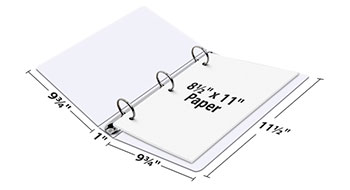Binder Sizes & Dimensions
When you're preparing for an important budget planning session or client meeting, a binder is great way to distribute handouts to your audience in one convenient, portable package. But without proper planning, you might discover at the last minute that your binders won't hold your biggest documents properly. Unless you want your presentation to turn into a complete disaster, it's vital to make sure your custom binders are the proper size for the materials you plan to include.
70+ Binders by Size
7" x 9" Binders (25)
7" x 9" binders are sized to fit half size materials, like a folded letter size sheet.
Important Things to Know
If you don't properly comprehend how your binder's size is measured or the amount of materials that it can comfortably hold, you might end up wasting money on a product that won't meet your needs. Review this helpful information to better understand the size of your binder and how that relates to its contents.
Binder Size vs. Paper Size
Binders are slightly larger than the paper they hold; for example, an average 9 3/4 x 11 1/2 inch binder is designed to hold standard 8 1/2 x 11 inch paper.

Hole Punch Spacing
Remember that if you want a document to fit into your binder's ring mechanism, you'll need to use a three-hole punch that complements the dimensions of the binder. For instance, when using a binder sized for half letter size paper (5 1/2" x 8 1/2"), you'll normally want the sheets to be punched with holes that are spaced 2 3/4 inches apart. If you're unsure what type of spacing you'll need, contact the Print Project Team.

Measuring Ring Size
Be aware that when people reference the size of a binder's rings, that size is measured in a slightly different way depending on which type of ring they're talking about. For round rings, it's the inside diameter of the ring–so a "one inch binder" will have rings with a diameter of one inch. With D rings and slant D rings, on the other hand, the size is the length of the ring's straight edge.

How Many Pages Does a 3-Ring Binder Hold?
The chart below illustrates the number of pages of 80# Text Gloss stock your binder will hold based on the size and shape of its rings, as well as the formula you can use to determine capacity with other types of paper stock.
BINDER RING CAPACITY
(sheet count based on 80# Text Gloss)
 |
 |
 |
||
| Round Ring | Slant D Ring | D Ring | ||
|
Ring Size
|
.5” | 91 | N/A | N/A |
| 1” | 187 | 212 | 250 | |
| 1.25” | 233 | N/A | N/A | |
| 1.5” | 280 | 318 | 375 | |
| 2” | 374 | 424 | 500 | |
| 2.5” | 467 | 530 | 625 | |
| 3” | 561 | 636 | 750 | |
| 4” | N/A | 848 | N/A | |
|
Capacity Rankings
|
 |
 |
 |
|
CAPACITY WITH OTHER STOCKS
To calculate capacities with other stocks, use the following
FORMULA
VARIABLES
| Chart Sheet Count | Refer to the chart above and find the sheet count listed for your desired ring size and type. |
| Stock Type | 24# Bond | 70# Text | 100# Gloss Text | 80# Cover |
| Stock Divisor | 1.13 | 1.25 | 1.45 | 2 |
Note that your capacity will be slightly smaller if you use index tabs; a tabbed sheet takes up as much space as roughly four non-tabbed sheets.

